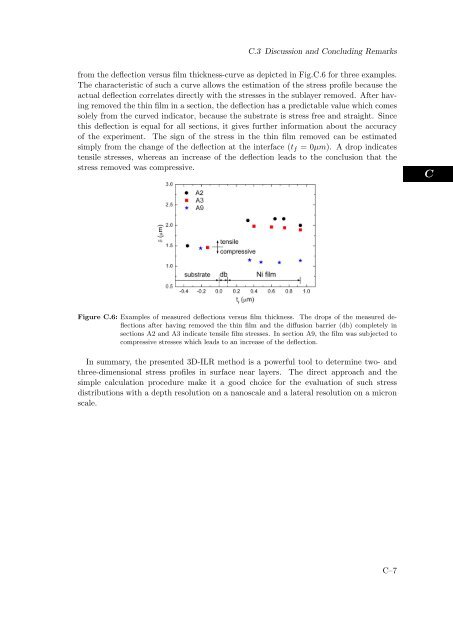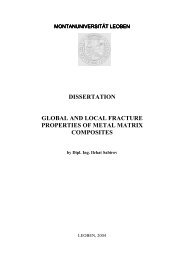1 - Erich Schmid Institute
1 - Erich Schmid Institute
1 - Erich Schmid Institute
You also want an ePaper? Increase the reach of your titles
YUMPU automatically turns print PDFs into web optimized ePapers that Google loves.
C.3 Discussion and Concluding Remarks<br />
from the deflection versus film thickness-curve as depicted in Fig.C.6 for three examples.<br />
The characteristic of such a curve allows the estimation of the stress profile because the<br />
actual deflection correlates directly with the stresses in the sublayer removed. After having<br />
removed the thin film in a section, the deflection has a predictable value which comes<br />
solely from the curved indicator, because the substrate is stress free and straight. Since<br />
this deflection is equal for all sections, it gives further information about the accuracy<br />
of the experiment. The sign of the stress in the thin film removed can be estimated<br />
simply from the change of the deflection at the interface (tf = 0µm). A drop indicates<br />
tensile stresses, whereas an increase of the deflection leads to the conclusion that the<br />
stress removed was compressive.<br />
Figure C.6: Examples of measured deflections versus film thickness. The drops of the measured deflections<br />
after having removed the thin film and the diffusion barrier (db) completely in<br />
sections A2 and A3 indicate tensile film stresses. In section A9, the film was subjected to<br />
compressive stresses which leads to an increase of the deflection.<br />
In summary, the presented 3D-ILR method is a powerful tool to determine two- and<br />
three-dimensional stress profiles in surface near layers. The direct approach and the<br />
simple calculation procedure make it a good choice for the evaluation of such stress<br />
distributions with a depth resolution on a nanoscale and a lateral resolution on a micron<br />
scale.<br />
C–7<br />
C
















